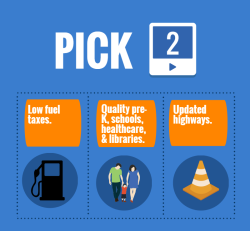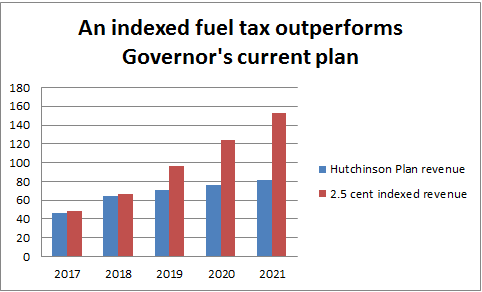
There’s a real need for new highway funding, but without some form of fuel tax increase, millions of new dollars for Arkansas’s roads and bridges means someone is going to be left holding the bag.
The governor wants to get through the first year by spending down some of the rainy day fund and using part of remaining surplus funds. As far as short term solutions, it could be a lot worse. But big problems with the Governor’s plan show up in year two and beyond. The plan leaves a number of important questions unanswered. Most concerning is: how will we handle the unprecedented withdrawal of general revenue funds, which are already taking a beating from the most recent two rounds of tax cuts? If the state fails to replace the funds taken out of general revenue, and there is no guarantee that they can or will be able to do so, the list of critical services that could be on the chopping block is long and alarming. Think of programs that protect abused and neglected children, kids in pre-k or afterschool and summer programs, public defenders and firefighters.
To successfully fund highways over the long-term, without gutting critical state programs, the Governor’s plan depends on three very big “ifs”:
- IF we have a steady positive surplus revenue for the life of the plan. This is very unlikely because surpluses naturally go up and down. Sometimes they are in the hundreds of millions, a lot of times they are zero. If we could perfectly predict them, they wouldn’t exist. It’s hard to imagine a fund as huge as the highway department’s rolling the dice on federal match dollars year after year.
- IF “efficiencies” can cover the cost of over $33 million in lost revenue annually by year 5. That is a lot of efficiency coming out of general revenue where many programs are already underfunded and facing more budget cuts. What is more likely is that programs we all care about like child protective services, education, state parks, police protection, and juvenile justice will be on the chopping block. If we fund highways with an additional cut to general revenue on top of the $242 million in tax cuts taking full effect in 2017, major cuts or unmet needs in these types of programs are inevitable.
- IF inflation is zero and cars don’t become more fuel efficient. The others are big if’s, but still in the realm of possibility. This one is the kicker. There’s no way that rising prices won’t erode the purchasing power of fuel tax revenue, just as they have over the past 15 years, and cars haven’t been getting any less fuel efficient recently. That matters because the farther you can go on a gallon of gas, the less you are chipping in to the gas tax that funds highways. And, since the fuel tax is a fixed price per gallon, it is effectively lowered every year because of rising prices. The cost of filling a pothole is going to be a lot more in 5 years, but with this plan, we are all going to be kicking in the same 21.5 cents per gallon to pay for it. If we don’t meet this final “if” (and we won’t), it means that it won’t be long before we are back where we started, and highways will be looking hungrily at general revenue again.
The solution is a modernized fuel tax
We need to modestly raise Arkansas’ gas and diesel taxes and index them to inflation as well as fuel efficiency. Starting off with just a 2.5 cent per gallon increase (which will cost about 37 cents extra every time you fill up your 15 gallon tank) will more than meet the governor’s first year highway funding totals with no need to raid the rainy day fund or surpluses. After the first 2.5 cent increase, we can cap those increases at 1.5 cents per year. That means that every year you’ll pay less than one extra quarter each time you fill up (assuming a 15 gallon tank). Small annual increases like this mean we won’t have to go back to the drawing board year after year. If you’re afraid of higher taxes, keep in mind that if our gas tax kept up with inflation, it would be 29 cents per gallon today. Instead it has been stuck at 21.5 cents per gallon since 2001. You can bet that the cost of construction has gone up since then.
This indexed fuel tax alone will fund over $150 million in highways needs annually by year five (Hutchinson’s plan only gets us to $81 million by then). That $150 million takes zero dollars out of general revenue or the rainy day fund. A modernized, indexed fuel tax is the only reasonable way to keep up with rising highway maintenance costs without continually going back to the well of state general revenue.
Here’s the breakdown:

The problem with the fuel tax is that, like most sales taxes, it is hardest on low-income working families. That is why any effort to keep this tax change “revenue neutral” has to start with an EITC (“Earned Income Tax Credit”) to help these families keep more of what they earn. An EITC would help the bottom 20 percent of earners in Arkansas, the only group left out of the recent $242 million in tax cuts.
Low fuel taxes are hurting our neighboring states, too
The governor pointed out that other nearby states have lower fuel taxes than we do. So, he implied, if they can do it without higher taxes, why can’t we? The short answer is that all of those state are making some painful sacrifices (like bond debt, private tolls, and gutted education funds) in exchange for their low fuel taxes, and they still have crumbling infrastructures.
The governor also pointed out that neighboring states seem to have no problem using general revenues for highways. Again, he seemed to imply, if it works there, why not here? That is comparing apples to oranges. All state budgets are structured very differently. The percentage of general revenue spent on highways is no real indication of the actual dollar amount going towards infrastructure. Texas spends 0% of state general revenues on highways, but it certainly doesn’t spend $0 total dollars on highways. Similarly, Tennessee spends 10% of general revenue on highways compared to our .01%, that doesn’t mean they spend 10,000 times as much on highways as we do. The percent of general revenue that other states spend on highways is irrelevant. The reason general revenue is a sacred cow in Arkansas is that it happens to fund our most critical services: the services that protect our elderly, our most vulnerable children, our natural spaces and our veterans.
Let’s take a closer look at what is really going on in each of our neighboring states. Hint: they are all desperate for highway revenue, and some budgets are turning cannibalistic- attempting to gobble up other funds like education to satisfy infrastructure.
- Louisiana: Louisiana hasn’t increased their gas tax since 1990, and therefore has a $12 billion backlog of infrastructure projects statewide. Every year millions of dollars that could go to highways are spent paying back bonds from previous years. The president of the Louisiana Good Roads Transportation Association called for a 10 cent gas tax increase in 2015, which would have cost the average driver only $1 a week. The association reports that a tax increase “may be the only way in which Louisiana’s unmet transportation needs will begin to be addressed.”
- Mississippi: Mississippi hasn’t increased its gas tax for decades (it has been 18.4 cents per gallon since 1987). That has left a growing hole in highway funds. A report from the Mississippi Economic Council in late 2015 reports that the state needs an additional $375 million more per year to keep bridges safe and maintain current roads and highways. Governor Bryant is in the unenviable position of searching for huge sums of highway funding while standing by promises to offset any new taxes with tax cuts elsewhere. That’s not going to be possible without major cuts to state services.
- Tennessee: Tennessee’s stagnant gas tax (no increase since 1989) has left the state with a $6 billion backlog of infrastructure projects statewide. Governor Bill Haslam is considering an increase to the gas tax to meet the state’s highway needs during the 2016 legislative session which began in January.
- Missouri: Only four states have lower gas taxes than Missouri. With long-term meager revenue for highways, it isn’t surprising that the state has the fourth lowest spending on infrastructure per mile. That neglect is catching up with legislators, who are making transportation a top of the priority in 2016. The governor and the Department of Transportation director support a proposal to increase the Missouri fuel tax by 1.5 cents per gallon in the upcoming legislative session. That would be the first increase since 1996.
- Oklahoma: Income tax cuts have reduced Oklahoma’s state revenue by over $1 billion annually since the mid 2000s. When you combine that with their paltry 16 cent gas tax, you are left with a funding standoff between core public services and highways. Right now, neither side is winning. 20% of Oklahoma bridges are structurally deficient (22 drivers cross a deficient bridge in the capital city every second) and 31% of Oklahoma roads are rated as inadequately safe.
- Texas: Some Texas lawmakers are about to break their arms patting themselves on the back for increasing per-capita highway spending by 50% since 2003 without any increase to the gas tax. That sounds too good to be true because it is. Texas has borrowed $18 billion (that’s billion with a “B”) during the past 10 years to make up for infrastructure budget shortfalls, relied on private company toll roads, and raided the rainy day fund to make ends meet.
Final thoughts
You might be surprised to find that funding highways with a 2.5 cent fuel tax increase would cost the average middle income Arkansan $25 a year. I think most of us would be willing to pay that extra 50 cents a week to have decent roads and prevent cuts to public services (like schools, parks and police protection). We have to make a decision. We cannot have functioning public services and safe roads while eternally refusing to increase any taxes.
